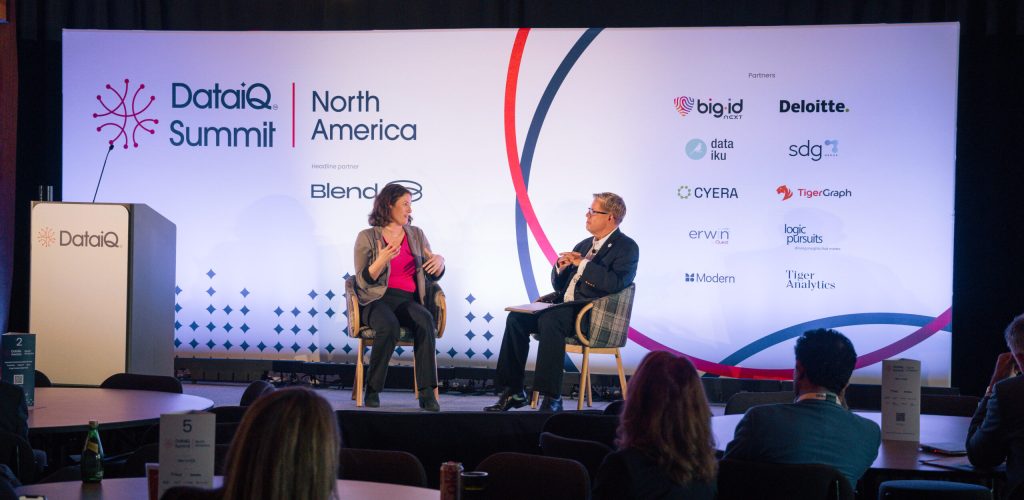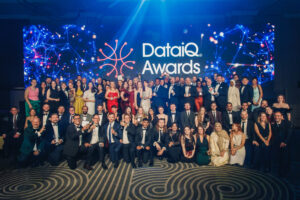Balancing Innovation and Risk for Value
In his keynote, Ryan Swann, CDAO, Vanguard, explored how organizations should approach balancing innovation and risk to unlock sustainable value from AI. Drawing on Vanguard’s experience scaling AI across a highly regulated environment, Ryan outlined a pragmatic framework for aligning data readiness, governance, and cultural transformation.
Key Takeaways:
- AI transformation occurs in three phases:
- Assist (automation)
- Augment (personalization via proprietary data)
- Action (changing how people and businesses work)
- Offense (innovation) and defense (risk management) must coexist, especially in regulated industries, to scale AI successfully.
- Adopt first-principles thinking to challenge assumptions.
- Shift risk by embedding privacy, ethics, and compliance early in the AI lifecycle.
- For agentic AI, teams must continuously monitor model behavior, guardrails, and performance.
A Strategic Investment Framework
Bhagyesh Phanse, CDAO, Starbucks Coffee Company and DataIQ 100 alumni, presented a practical investment and strategy framework for data leaders to align their teams’ efforts with measurable business value. Drawing on real-world portfolio management principles, he emphasized the importance of balancing analytics types, funding approaches, and operational enablers to maximize impact.
Key Takeaways:
- Whether mitigating risk or driving impact, always align data and analytics work with measurable organizational outcomes.
- Avoid one-size-fits-all measurement and embed an aligned operating model.
- Classify analytics by purpose and distinguish between exploratory research and product-driven work to better assess return on effort.
- Use a dual-spectrum framework combining analytics intent and investment approach to map work across four types: frontier, research, applied, and mandatory/enabling.
- Balance portfolios with a mix of long-term innovation and short-term, value-generating initiatives.
- Track value with purpose-built KPIs on one or two primary metrics per project that clearly reflect its intended impact, supplemented by secondary indicators.
Strategy Meets Execution
Dimitri Sirota, CEO and Co-Founder, BigID, examined balancing generative AI-enabled innovation with scalable governance, privacy, and compliance, emphasizing that trust is not a tradeoff, but a multiplier.
Risk is an integral part of data and AI success, meaning it must be managed with in-depth assessments of AI classification, governance assessments, implementation and enforcement of guardrails, and regular investigations into data risks across the organization. LLMs thrive on unstructured data, so organizations must identify, manage, and govern this data effectively.
Key Takeaways:
- Classify data by both value and risk (business-critical versus sensitive).
- Use existing taxonomies and glossaries to map unstructured content.
- Ensure searchability of data via semantic or vectorized search technologies
- Build curated datasets for RAG and fine-tuning by pulling data from multiple sources:
- SaaS platforms
- Repositories
- Chat systems
- Data lakes
Risk needs to be addressed:
- By identifying sensitive information.
- Through automated tools that can redact, tokenize, or de-identify data before training.
- By detecting qualitative issues such as bias and regulatory non-compliance (GDPR, CCPA, ITAR).
Embedding AI in Organizations
Meaghan Ferrigno, Senior Vice President and Chief Data and Analytics Officer, Destination Canada and DataIQ 100 alumni and 2025 DataIQ Awards North America winner, shared how Destination Canada embedded AI at the heart of a national strategy to transform the tourism sector. She detailed the creation of the Canadian Tourism Data Collective and the Traveler Twin, showing how a small public-sector team delivered scalable, AI-driven impact across an entire industry.
Key Takeaways:
- AI must be embedded into technology, strategy, and operations from the start.
- Focus on building useful and accessible AI platforms for collective intelligence.
- Generative AI is a tool to create a conversational digital persona enabling real-time, intuitive access to insights.
- This approach replaced static dashboards with dynamic, human-like interactions, improving the design and deployment of campaigns.
- Destination Canada achieved +500% platform usage, 75% engagement rates, an 18-month reduction in time-to-insight, and $4.5 million in value per subscribed partner.
- Design thinking and co-creation were central to success.
These keynotes offer a practical blueprint for embedding AI strategically while balancing innovation, risk, and measurable value. Whether scaling responsibly in regulated environments, aligning investments with impact, or transforming sector-wide decision-making, success lies in thoughtful design, trust in data, and relentless focus on outcomes.





